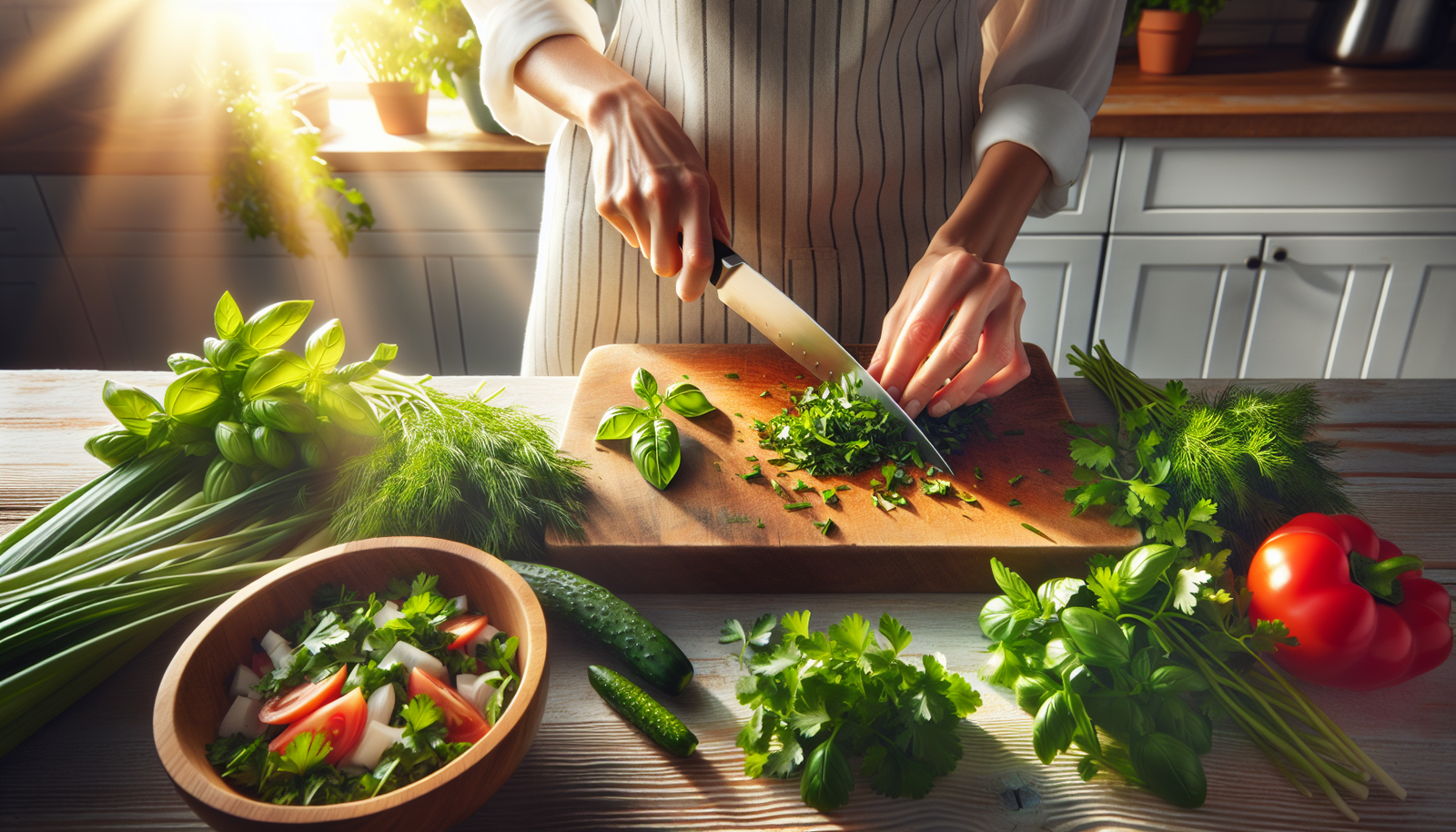
How to Use Fresh Herbs in Sauces and Dressings
Fresh herbs in sauces and dressings add not only vibrant flavor but also elevate culinary creations to new heights. Imagine transforming a simple vinaigrette with the addition of basil or mint, turning a basic pesto into something extraordinary. Herbs like cilantro, dill, and parsley can enhance and balance the flavors in dressings and sauces, making meals more exciting and memorable. This post will explore effective ways to incorporate fresh herbs into your everyday sauces and dressings, maximizing their aromatic potential. Discover how using herbs can significantly enhance both the taste and the presentation of your culinary efforts.
Benefits of Using Fresh Herbs in Sauces and Dressings
Integrating fresh herbs into sauces and dressings elevates your culinary creations. They offer unique flavors and contribute to a healthier diet. Fresh herbs have the power to transform any dish into something memorable.
Nutritional Advantages of Fresh Herbs
Fresh herbs are nutritional powerhouses. They offer a range of essential vitamins and minerals. Herbs like basil, parsley, and cilantro are rich in vitamins A, C, and K.
Antioxidants present in fresh herbs help fight inflammation. They also support immune health. Including fresh herbs in your diet can boost overall wellness.
Herbs like rosemary and thyme are known for their medicinal properties. They support memory function and digestion. A diet rich in fresh herbs can support heart health and reduce blood pressure.
Enhanced Flavor Profiles in Culinary Applications
Fresh herbs add nuanced flavors to dishes. They can complement or contrast existing flavors. This creates a more robust taste experience.
Adding fresh herbs can balance the acidity or sweetness in sauces. Basil brings sweetness, while cilantro adds a citrusy note. These subtle changes can elevate any sauce or dressing.
Spices and herbs work together to create complex flavors. A simple tomato sauce can transform with the right blend of basil and oregano. Fresh herbs are essential for authentic flavor profiles.
Versatility in Various Types of Cuisines
Fresh herbs are incredibly versatile in culinary applications. They adapt to a variety of cuisines easily. Whether making a Mediterranean dish or Asian-inspired meal, fresh herbs fit perfectly.
Cilantro is a staple in Mexican and Thai dishes. Basil finds its home in Italian and French cuisine. This versatility makes fresh herbs a valuable asset in any kitchen.
Herbs can also be used in fusion dishes. They help bridge different culinary traditions. This makes them ideal for adventurous home cooks.
Popular Fresh Herbs for Sauces and Dressings
Some herbs are staples for sauces and dressings. They are known for their distinctive flavors and culinary uses. Here are a few fresh herbs that can enhance any kitchen repertoire.
Basil: A Classic Choice for Italian and Mediterranean Sauces
Basil is synonymous with Italian and Mediterranean cooking. Its sweet and peppery flavor pairs perfectly with tomatoes. It is essential in sauces like pesto and marinara.
Fresh basil adds brightness to any dish. It can be used whole or chopped. Basil is also a key ingredient in Greek and Provençal cuisine.
Growing basil at home ensures a constant supply of this aromatic herb. It’s easy to cultivate and thrives in sunny conditions.
Cilantro: A Fresh Addition to Mexican and Asian Dressings
Cilantro offers a fresh and citrusy flavor. It is a popular choice in Mexican salsas and Asian dressings. Its unique taste can liven up any dish.
In Mexican cuisine, cilantro is often paired with lime. In Asian dishes, it’s combined with ginger and soy. This versatility makes it a must-have herb.
For those new to cilantro, starting with small amounts is key. Its flavor can be overpowering to the unaccustomed palate.
Parsley: Its Role in Enhancing Flavor in Diverse Preparations
Parsley is often underestimated. However, it plays a crucial role in many dishes. It adds freshness and balances flavorful ingredients.
Parsley is commonly used in Mediterranean and Middle Eastern cuisine. It is an essential component of tabbouleh and chimichurri.
This herb is not only used for garnish. Chopped parsley can enhance the flavor profile of soups and stews. It is a versatile addition to any kitchen.
Tips and Techniques for Incorporating Fresh Herbs
Getting the most out of fresh herbs requires proper handling. From storage to preparation, every step impacts their flavor and aroma. Here are some tips to ensure your herbs shine in every dish.
Proper Storage to Maintain Freshness and Flavor
Storing fresh herbs correctly prolongs their shelf life. Most herbs can be kept fresh in the refrigerator. Wrap them in damp paper towels and store in a plastic bag.
Some herbs, like basil, prefer room temperature. Place stems in a glass of water, like a bouquet. Cover loosely with a plastic bag for optimal freshness.
Freezing herbs is another option for long-term storage. Chop and freeze in ice cube trays with water or olive oil. This method preserves their flavor for later use.
Best Practices for Chopping and Preparing Fresh Herbs
Properly preparing herbs enhances their flavor. Use a sharp knife to chop herbs finely. This releases their essential oils without bruising.
For delicate herbs like basil, tearing by hand can preserve flavor. Avoid over-chopping as it can lead to bitterness.
Herbs should be washed and dried thoroughly before use. Excess moisture can dilute their flavor and alter the texture of the dish.
Timing for Adding Herbs to Maximize Aroma and Taste
Timing is crucial when adding herbs to dishes. Some herbs are best added early in cooking. Others should be used as a finishing touch.
Hardy herbs like rosemary and thyme can withstand longer cooking times. Delicate herbs like basil and cilantro should be added at the end.
This ensures their flavors remain vibrant and fresh. Experiment with timing to find the best balance for each dish.
Conclusion
Fresh herbs enhance the flavor, aroma, and color of sauces and dressings. Popular herbs include basil, cilantro, parsley, dill, and mint. Incorporating herbs can elevate simple recipes and provide a vibrant, fresh taste. Herbs can be mixed, chopped, or pureed, depending on the intended consistency and flavor profile. Practicing with different combinations helps find the best match for specific dishes.
FAQ
How can I store fresh herbs to maintain their flavor in homemade dressings?
Store fresh herbs by wrapping them in a damp paper towel and placing them in a sealed plastic bag in the fridge. This keeps them fresh and retains their flavor longer, perfect for enhancing homemade dressings.
What are the best fresh herbs for enhancing salad dressings?
Basil, cilantro, dill, and parsley are ideal for enhancing salad dressings. These herbs add vibrant flavors and aromas, elevating the taste of your dressings.
Can fresh herbs replace dried ones in sauce recipes, and how?
Fresh herbs can replace dried ones by using a 3:1 ratio, as fresh herbs are less potent. Chop them finely to release their flavors, making sauces more aromatic and flavorful.
What is the shelf life of fresh herb-infused sauces in the refrigerator?
Fresh herb-infused sauces typically last 5 to 7 days in the refrigerator. Store them in an airtight container to preserve their freshness and taste.
How do you properly prepare fresh herbs for use in creamy sauces?
Wash fresh herbs thoroughly under cold water, then pat them dry with a clean towel. Chop finely to ensure they blend well into creamy sauces, releasing their full flavor.
What are the health benefits of using fresh herbs in salad dressings?
Fresh herbs provide antioxidants, vitamins, and minerals. They can boost immunity, reduce inflammation, and enhance overall health when used in salad dressings.











